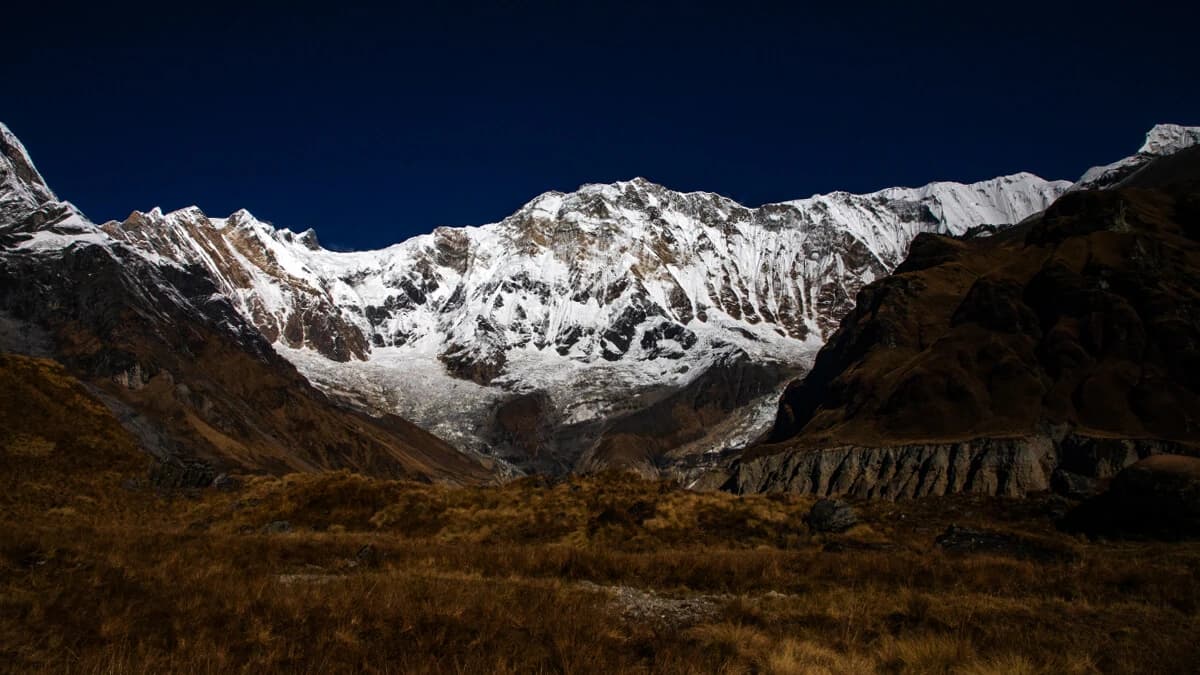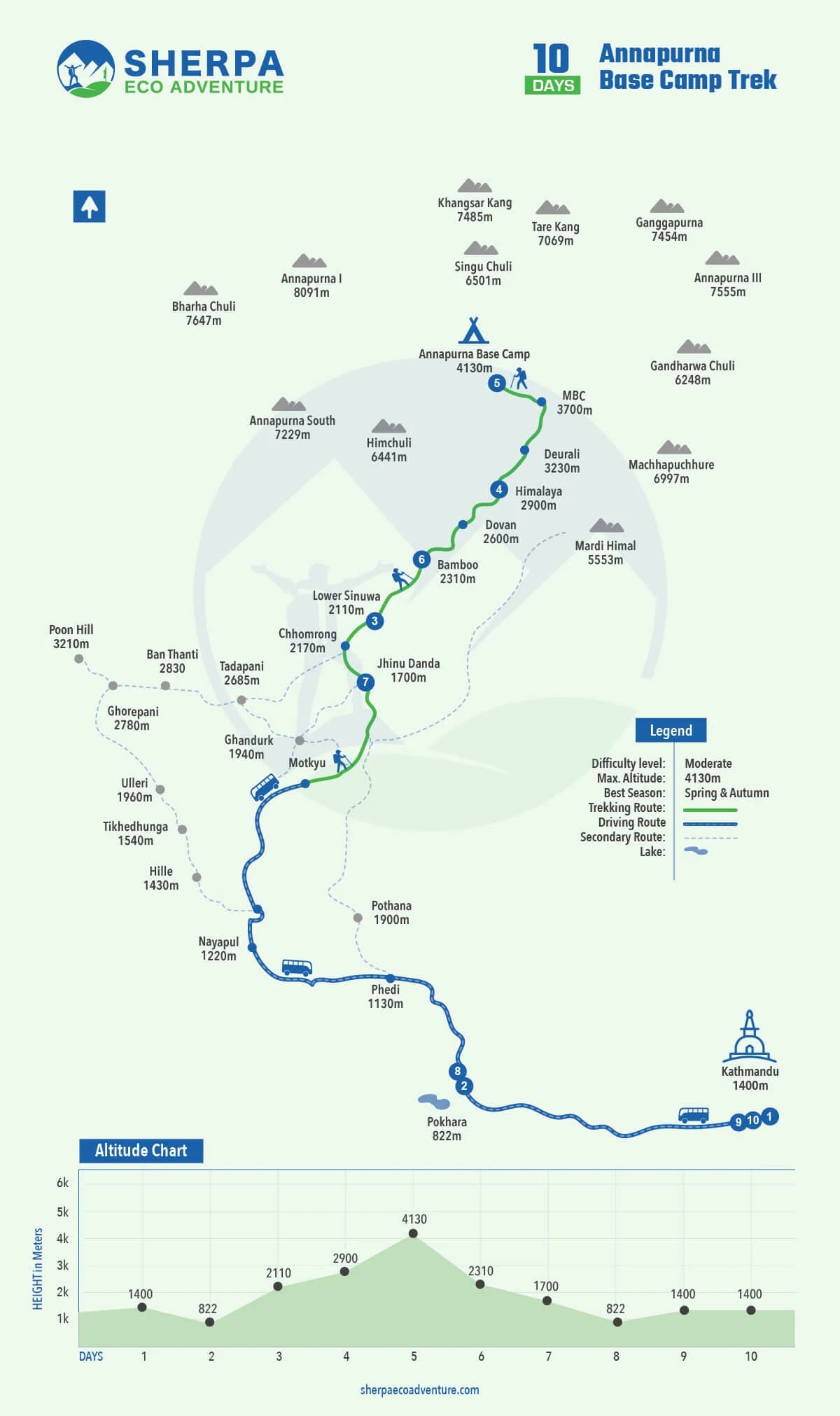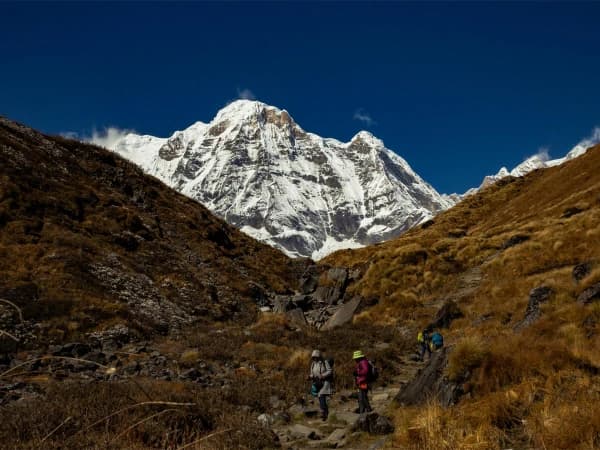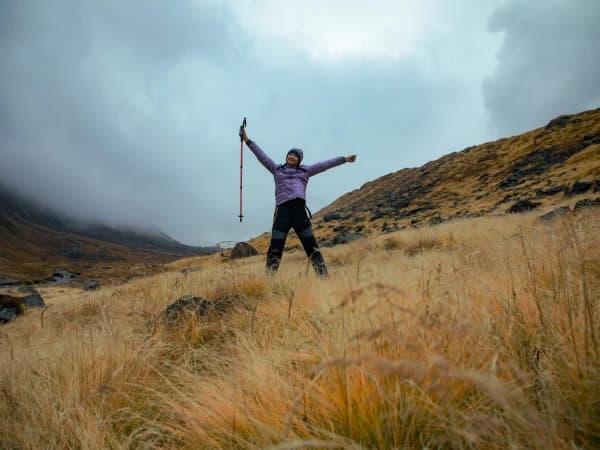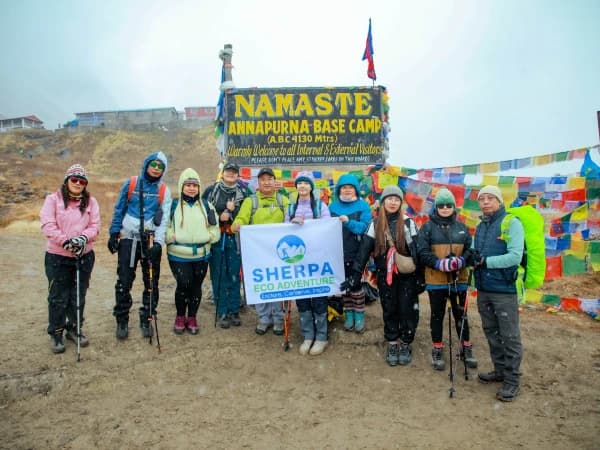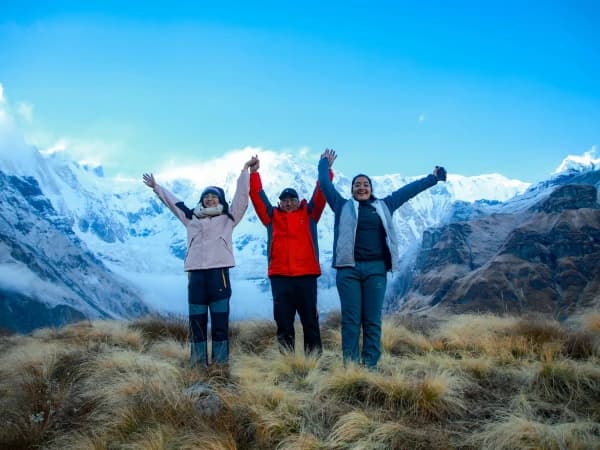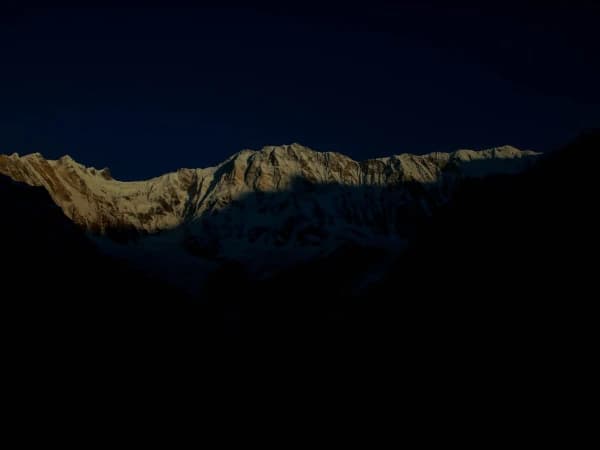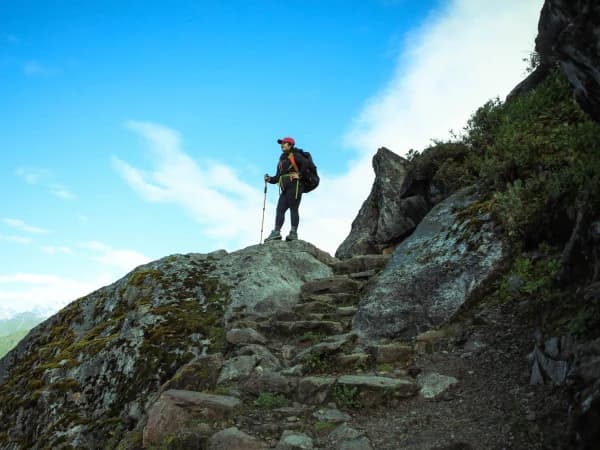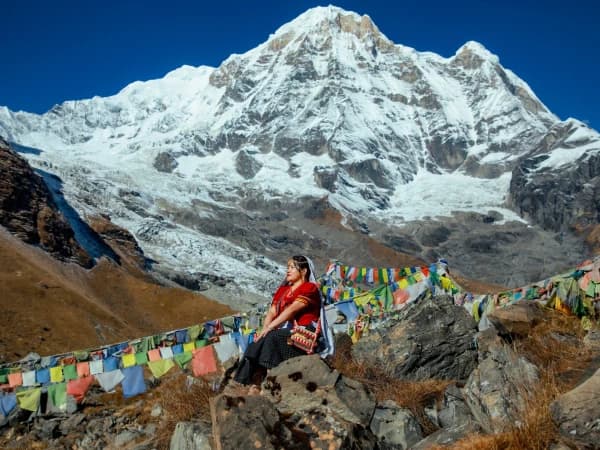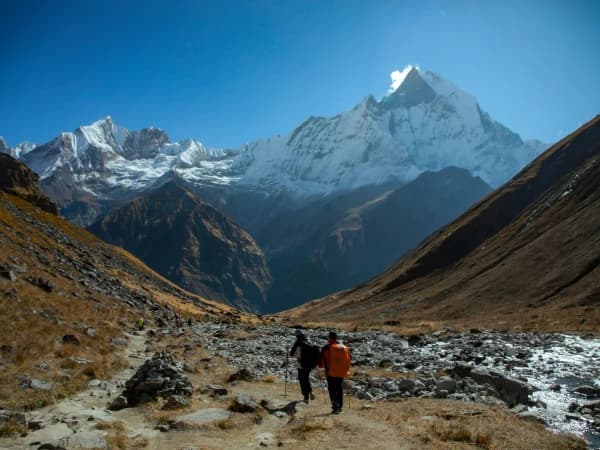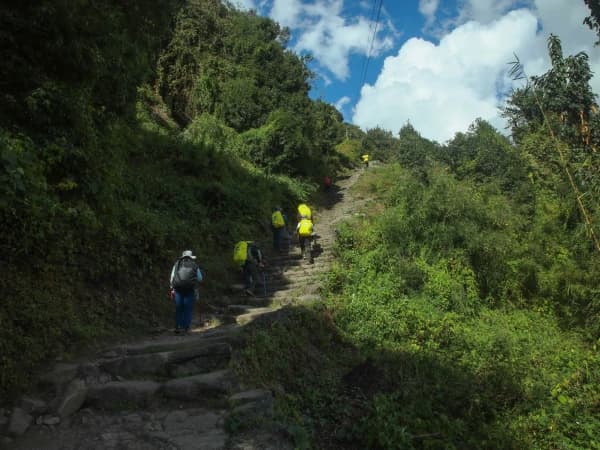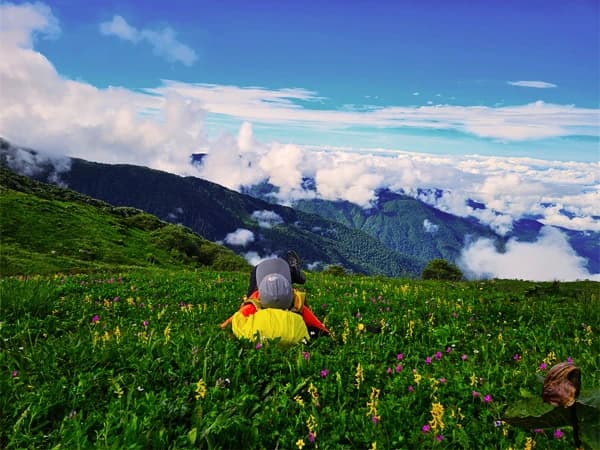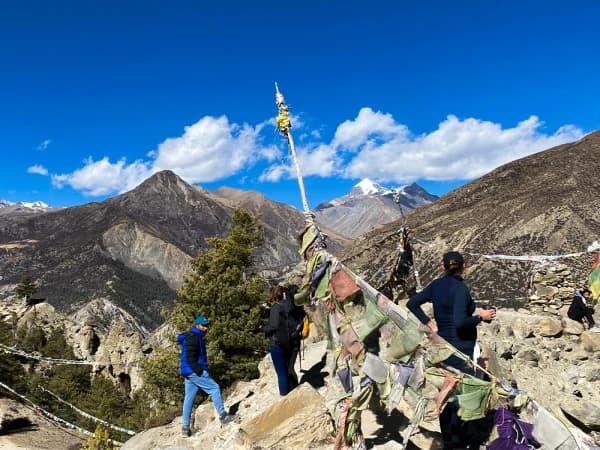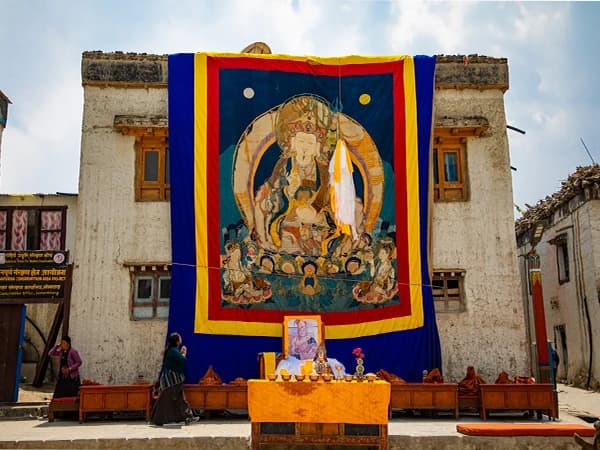The Annapurna Base Camp trekking stands out as the favorite trekking experience in present-day Nepal, offering exhilarating adventure across diverse landscapes, including terraced fields, rhododendron forests, and high-altitude alpine meadows. Spanning a duration of 7 to 12 days, the trek provides stunning panoramic views of towering peaks such as Annapurna I, Machhapuchhre, and Dhaulagiri.
Boasting authentic Gurung culture, warm hospitality, awe-inspiring mountain vistas, and thrilling trails, the 8-day Annapurna Base Camp trekking is cherished as one of the most beloved routes near Pokhara. The trails have convenient accessibility and a moderate pace. The hospitality of the Gurung community in Chhommorong and every hotel collectively transforms this adventure into a once-in-a-lifetime journey.
Bookings for the Annapurna Base Camp Trek 2026-2027 are now open! Take advantage of our special holiday discount on the trek cost by securing your spot in advance for next year. Do not miss out on the best Annapurna Base Camp trek package available.
Highlights
- Immerse yourself in the genuine Gurung culture, enjoy heartfelt hospitality, and behold the awe-inspiring Annapurna range amidst stunning landscapes.
- Embark on an exciting trekking journey through vibrant rhododendron forest, charming Gurung villages, and picturesque surroundings, accompanied by the soothing sounds of the Modi River flowing alongside.
- The Annapurna Base Camp is conveniently situated near Pokhara within the Annapurna Sanctuary, ensuring swift accessibility to the trial.
- It is a popular and well-loved trail, ideal for novice and seasoned trekkers, as well as well-managed trails.
- Encounter the hospitable Gurung community and other smaller local ethnic groups.
- Witness their way of life and rich cultural traditions.
- Discover the ancient Gurung civilization along the Chhommrong River and Modi River.
- Learn about the traditional Gurung method of wild honey hunting.
- Embark on a hike to the Annapurna Base Camp viewpoint for a breathtaking sunrise and panorama of the majestic Annapurna mountain range.
- Encounter a diverse array of flora and fauna while trekking through the Annapurna Sanctuary.
- Experience a spectrum of landscapes and immerse yourself in the diverse topographical wonders of Annapurna Base Camp
What can you expect from the Annapurna Base Camp trek?
The Annapurna Base Camp Trek is located in the Annapurna region of Nepal and offers an enchanting expedition through a blend of natural and cultural marvels. Journey through verdant rhododendron forest and terraced field meanders amid traditional Nepalese villages, and engage with the vibrant tapestry of Gurung and Magar communities.
Enchanting villages like Chhommrong and Bhanuwa exhibit the allure of classic Nepali architecture. Take pleasure in the rejuvenating warmth of natural hot springs in Jhinu Danda, a welcome relief for fatigued muscles. The route is dotted with teahouse accommodations, providing an opportunity to connect with fellow trekkers in modest yet comfortable lodgings.
Negotiate diverse terrain, from gentle slopes to challenging ascents and descents, requiring physical preparation throughout. The apex is the breathtaking Annapurna Base Camp, perched at 4,130 meters and presenting sweeping views exceeding 7,000 meters, including Annapurna I. Weather considerations necessitate readiness for varied conditions, and though not as towering as some destinations, altitude demands acclimatization and hydration. Optimal trekking seasons are pre-monsoon and post-monsoon, and essential permits such as the Annapurna Conservation Area Permit are crucial. Stay informed about evolving conditions and regulations and contemplate the invaluable assistance of local guides or porters, especially for those trekking in the region for the first time.
Is Annapurna Base Camp trekking right for you?
Upon your arrival, the Gurung community extends a warm welcome, providing you with an opportunity to gain insights into their Himalayan livelihood. As you trek amidst the flora, you experience an abundance of oxygen. As you approach the Machhapuchhre Base Camp at an elevation of 3800 meters, the alpine environment gradually embraces you, with the majestic Himalayas towering above.
If you have the desire to witness the majestic Annapurna I, the 10th highest peak globally, and relish the enchanting spectacle of the first sunrise casting its rays upon the summits of the Annapurna range, then the Annapurna Base Camp trek package is tailor-made for you. Delight in the adventure within the gorges nestled between Machhapuchhre and Annapurna South-Hinchuli, an experience that is bound to captivate you. The awe-inspiring panorama of the Annapurna range may surpass any preconception you had, truly transcending the limits of your imagination.
To embark on a Himalayan trek, it’s crucial to prepare both physically and mentally. If you’re considering your inaugural trek in Nepal, the Annapurna Base Camp trellis is an ideal choice. This package offers an exceptional experience, showcasing the proximity of Pokhara, the world’s only city, where you can behold three peaks surpassing 8000 meters (Annapurna I, Dhaulagiri, and Manaslu). The Annapurna Base Camp trek provides a comprehensive introduction to trekking, featuring diverse natural and cultural elements. Spanning 10 days, the Annapurna Base Camp route is not overly challenging.
Our team of professional guides and porters is dedicated to ensuring your trek is completely safe. The Annapurna Base Camp trek is highly sought after, following the Everest Base Camp Trek (EBC) trek in Nepal. Anticipate basic conditions, swiftly changing weather, and the potential challenge of altitude sickness.
And if you feel like extending the trek, you can easily combine the Ghorepani Poonhill Trek or Mardi Himal Trek
Perks of doing the Annapurna Base Camp trek with us
When we are with you, our knowledgeable Sherpa Eco Adventure team, the Annapurna Base Camp trek becomes a well-organized and worry-free adventure. With their steadfast assistance, you can embark on this journey with complete peace of mind. Our committed SEA team is devoted to ensuring your safety throughout the trekking, providing you with a hassle-free experience of Annapurna Base Camp trekking.
Should you have any inquiries about the Annapurna Base Camp trekking, do not hesitate to contact us. Additionally, we’ve outlined below some additional perks you’ll enjoy when trekking with the Sherpa Eco Adventure team.
- Embark on your trek with a porter and a friendly, knowledgeable trekking guide.
- Adaptable schedule that you can personalize at any time.
- Exceptional service and warm hospitality
- The best Annapurna Base Camp trekking cost offers excellent value for your investment.
- Assist you without any limitation to any specific time of day or night.
- Includes welcome and farewell dinners, along with airport transfers as outlined in the itinerary
- There are no undisclosed fees or policies.
